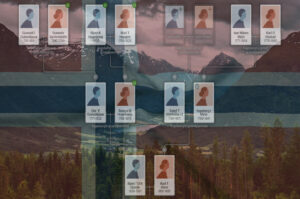It’s important to consider the cultural and historical context when deciding on preferred names for ancestors with both American and Norwegian names. Mixing both names may be appropriate if the individual used both names interchangeably during their lifetime or if they were known by both names in their community. However, if an individual only used their Norwegian name, it may be more respectful to use that name exclusively.
Using the most identifiable placename as the last name can be a helpful way to differentiate individuals with common names, but it’s important to be mindful of how this decision may impact the individual’s cultural identity. For example, some individuals may identify more strongly with their family surname than with a placename that only represents a small part of their ancestry.
When it comes to including additional placenames or alternate names, it’s important to use discretion and consider the significance of these names in the individual’s life. Including them as an additional middle name or alternate name can be a good compromise if they were used significantly, but it’s important not to add unnecessary information that may confuse or detract from the individual’s story.
Let’s focus on Ben Gjerde to illustrate, that’s his American name. His Norwegian name is Bjørn Olsen and Bjørn with American letters is Bjorn. In my ancestry tree for the primary name, I use only English letters which means ü is u, ø is 0, ó is 0, etc. For example, Bjorn Olsen’s most significant placename in Norway is Bubakken, so a name of Bjorn “Ben” Olsen Gjerde Bubakken might be best. However, late in life he changed his name to Ben Gjerde, not Ben Bubakken so I use Gjerde as his Last Name.
I freely add alternate names to everybody in my family tree. I do this for easy searching of databases. I do use the Norwegian characters in alternate names. For example, for Ben I’ve chosen Bjorn “Ben” Olsen Bubakken Gjerde as his preferred name. Her are my primary alternates, the ones I plan on keeping:
- Bjørn Olsen Bubakken, the most common in Norwegian records.
- Bjørn Olsen Gjerde, his presumed last farm in Norway and his chosen surname late in life.
- Benjamin “Ben” Oleson, first American name used for decades.
- Benjamin “Ben” Gjerde, final American name chosen.
I also have secondary alternates I plan on purging in the future when I’m done searching. They are used for searching only, and include:
- Bjorn Olson Jerde, name used on his church death record.
- Bjorn Olsen Bubakken
- Bjorn Olesen
- Bjørn Olesen
- Bjórn Olesen
- Ben Olesen
- Bjorn Olson
- Bjørn Olson
- Bjórn Olson
- Ben Olson
- Bjorn Olsen
- Bjørn Olsen
- Bjórn Olsen
- Ben Olsen
I switch the preferred name to an alternate for a few searches. It works! When it’s time to purge, I delete the names that are not linked to any sources. If a name is linked to a source, I use FTM to merge the name with the appropriate name I’m keeping.
Search Tips:
I put the following additional alternate names for ease in searching.
- I put each additional placename as an alternate name using their original Norwegian characters.
- For females I do put their married name sometimes.
- I also put common miss-spellings I find in records as alternate names.
- Sometimes, when I’ve learned enough about a person, I’ll use FTM to merge their alternate names together into the most common alternate name or names.
Note: Some like to put the Norwegian given name and surname in the First and Middle name field, and put all the relevant placenames in the Last Name field using dashes or spaces (i.e. Tollef Tollefsen, Intelhuus-Hornet). I like this too as the given name and surname, i.e. Tollef Tollefsen, is the person’s name. The placenames are just location identifiers. Sure, many placenames became fixed surnames, so I try to make the best decision for each person.
Kari’s side example placenames:
- Kari Horn, a.k.a. Kari Tallefsdatter Hornet. I only see the placename Hornet.
- Kari’s dad Tollef Tollefsen Hornet. I only see the placename Hornet, but some ancestry records cite Intelhüüs, but I’m not sure if that’s a placename or an attempted fixed surname.
In conclusion, choosing the preferred name for ancestors with both American and Norwegian names requires careful consideration of cultural and historical context. Mixing names may be appropriate if the individual used both interchangeably or if they were known by both names in their community. However, if an individual only used their Norwegian name, it may be more respectful to use that name exclusively. Adding alternate names can be useful for database searches, but it’s important to be mindful of their significance and not add unnecessary information that may detract from the individual’s story. Ultimately, the goal is to honor and respect the individual’s identity and heritage.






